C++初阶------------------入门C++
作者前言
🎂 ??????🍧🍧🍧🍧🍧🍧🍧🎂
?🎂 作者介绍: 🎂🎂
🎂 🎉🎉🎉🎉🎉🎉🎉 🎂
🎂作者id:老秦包你会, 🎂
简单介绍:🎂🎂🎂🎂🎂🎂🎂🎂🎂🎂🎂🎂🎂🎂🎂
喜欢学习C语言、C++和python等编程语言,是一位爱分享的博主,有兴趣的小可爱可以来互讨 🎂🎂🎂🎂🎂🎂🎂🎂
🎂个人主页::小小页面🎂
🎂gitee页面:秦大大🎂
🎂🎂🎂🎂🎂🎂🎂🎂
🎂 一个爱分享的小博主 欢迎小可爱们前来借鉴🎂
C++入门引入
命名空间(namespace)
在我们学习C语言的过程中,如果我们命名一些和库函数名字相同的变量或者函数,VS编译器就会报错,怎么解决这个问题呢?C++语言就推出了一个关键字
namespace
这个关键字的作用就是解决命名冲突的
未使用关键字:
#include<stdio.h>
#include<stdlib.h>
int rand = 0;
int main()
{
printf("%d", rand);
return 0;
}
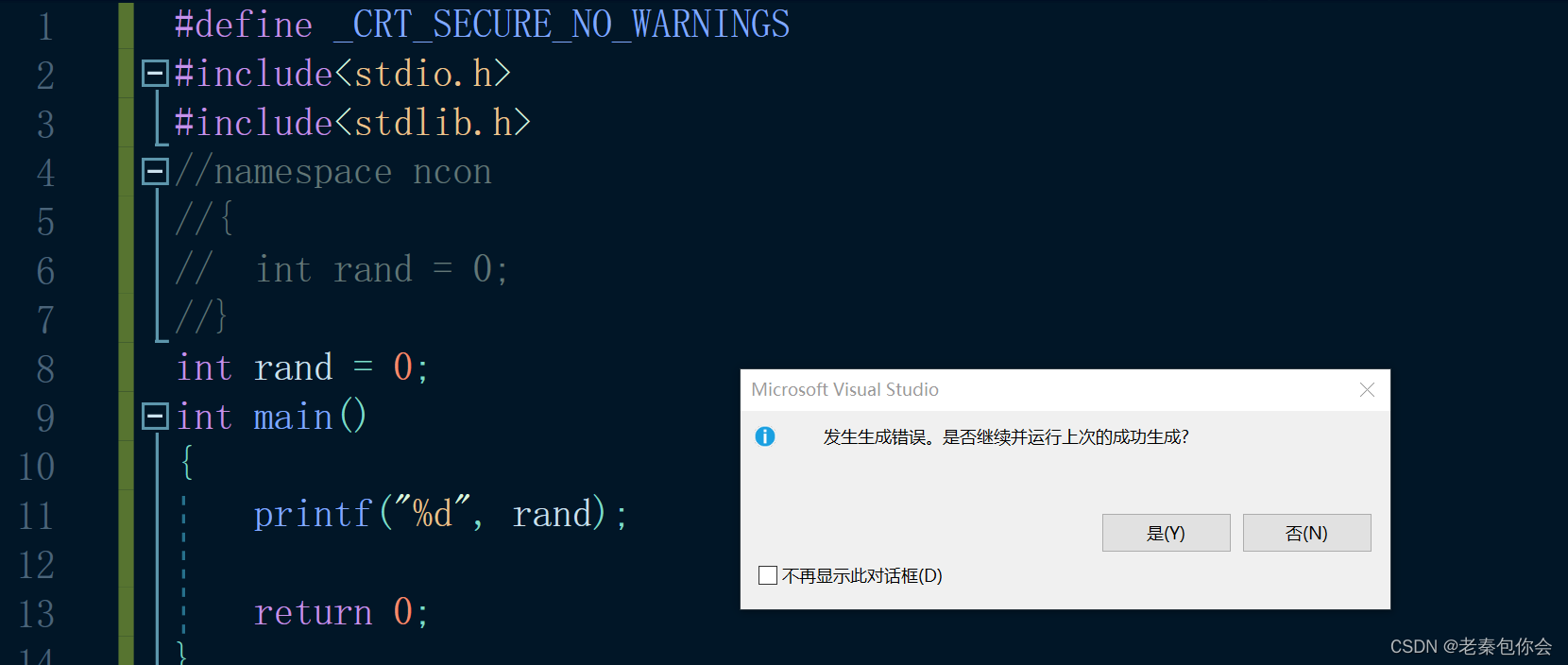
是会报错的,因为命名和库函数rand冲突了,我们在后面写的代码越多,就越容易命名冲突,
使用关键字:
#include<stdio.h>
#include<stdlib.h>
namespace ncon
{
int rand = 0;
}
int main()
{
printf("%d", ncon::rand);
return 0;
}

::
这个符号叫域作用限定符
就是告诉VS编译器rand这个变量要在ncon命名的空间里面找,否则是找不到这个rand的
在命名空间里面可以定义函数、结构体、变量、枚举…等,
#include<stdio.h>
#include<stdlib.h>
namespace ncon
{
int rand = 0;
int Add(int a, int b)
{
return a + b;
}
typedef struct numnam
{
int a;
int b;
}numname;
}
int main()
{
printf("%d ", ncon::rand);
int count = ncon::Add(1, 2);
printf("%d ", count);
struct ncon::numnam num = { 10,20 };
printf("%d %d", num.a, num.b);
return 0;
}
注意一下,结构体的写法是struct关键字在 最前面
命名空间里面嵌套命名空间
#include<stdio.h>
#include<stdlib.h>
namespace ncon
{
namespace con
{
int nums = 10;
}
}
int main()
{
printf("%d ",ncon::con::nums);
return 0;
}
命名空间可以嵌套命名空间,无限套娃
命名空间的合并
我们在一个源文件中可以多个位置命名空间相同的名字,是不会冲突的,会合并成一个命名空间
头文件:
#include<stdio.h>
#include<stdlib.h>
namespace ncon
{
typedef struct numnam
{
int a;
int b;
}numname;
}
目标文件.c
#include"day1_1.h"
using namespace ncon;
namespace ncon
{
int Add(int a, int b)
{
return a + b;
}
}
int main()
{
int count = Add(1, 2);
printf("%d ", count);
struct ncon::numnam num = { 10,20 };
printf("%d %d ", num.a, num.b);
return 0;
}
有人就会发现下面这句代码
using namespace ncon;
这句代码想表达的意思就是
这行代码是C++中的语法,意思是引入命名空间 ncon 中的所有内容,使得在代码中可以直接使用该命名空间中的成员而不需要加上前缀
注意:这种方式不提倡,特别是在项目里会造成不必要的麻烦,所以日常练习可以展开
std:是C++官方库定义的命名空间
但是有时候真的很麻烦,会写很多不必要的前缀
所以我们可以指定展开
using std::cout;
using std::endl;
第一个c++代码
#include<iostream>
int main()
{
std::cout << "hello world";
printf("hello world");
return 0;
}
<< : 流插入
如果要写入一些标识符,如\n
#include<iostream>
int main()
{
std::cout << "hello world\n" << "hello " << "11111 " << "\n";
printf("hello world");
return 0;
}
可以写多个 << 进行拼接
但是一般不会这样写,会写成是std::endl
#include<iostream>
int main()
{
std::cout << "hello world" << std::endl << "hello " << "11111 " << std::endl;
printf("hello world");
return 0;
}
?<< :流提取
#include<iostream>
using std::cout;
using std::endl;
using std::cin;
int main()
{
int a = 10;
int b = 20;
cin >> a >> b;
cout << a << endl << b;
return 0;
}

std:: cin :输入
std::cout : 输出
缺省参数
我们知道在C语言中,函数的有参数就必须传参,不传参就会报错,为了解决这个问题,c++就有了可以拥有默认参数的函数
#include<iostream>
using std::cout;
using std::endl;
using std::cin;
namespace ncon
{
void Func(int a = 10)
{
cout << a << endl;
}
void Func1(int a = 10, int b = 20, int c = 100)
{
cout << a << endl;
cout << b << endl;
cout << c << endl;
}
}
using namespace ncon;
int main()
{
ncon::Func();
ncon::Func(30);
Func1();
Func1(100);
Func1(1,1,1);
return 0;
需要注意的是缺省值只能从右往左给,必须是连续给
还有一些是半缺省的函数
void Func(int a, int b = 10, int c = 20)
{
cout<<"a = "<<a<<endl;
cout<<"b = "<<b<<endl;
cout<<"c = "<<c<<endl;
}
半缺省参数必须从右往左依次来给出,不能间隔着给
声明和定义不能同时给参数,只能在声明的时候给。这个是一个默认规定
在头文件中
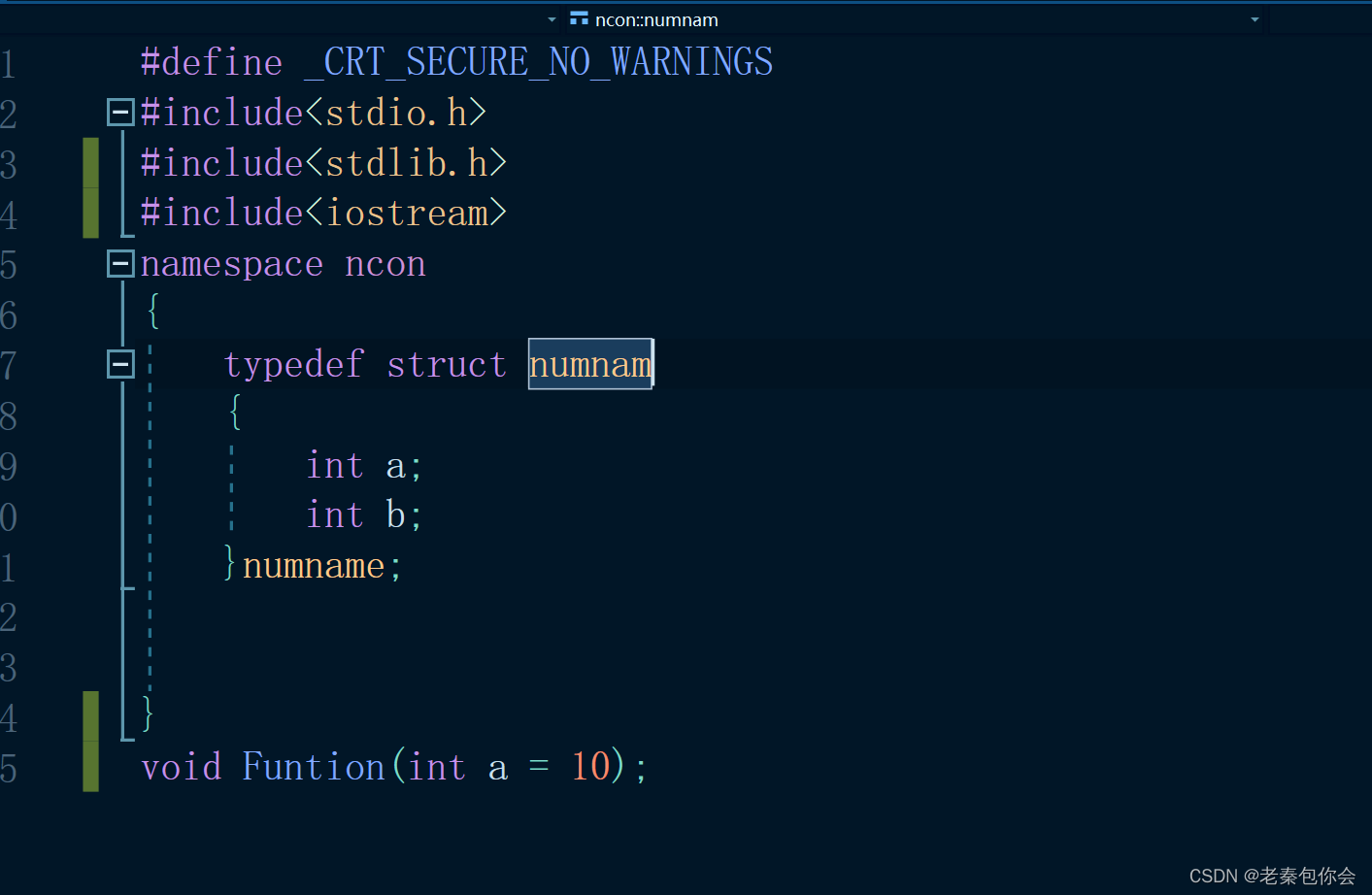
缺省值必须是常量或者全局变量
函数重载
函数重载:是函数的一种特殊情况,C++允许在同一作用域中声明几个功能类似的同名函数,这
些同名函数的形参列表(参数个数 或 类型 或 类型顺序)不同,常用来处理实现功能类似数据类型
不同的问题。
#include<iostream>
using std::cout;
using std::endl;
using std::cin;
//参数类型不同
int Add(int a, int b)
{
return a + b;
}
double Add(double a, double b)
{
return a + b;
}
//参数个数不同
void Fun()
{
cout << "Fun()" << endl;
}
void Fun(int a)
{
cout << "Fun(int a)" << endl;
}
// 参数的顺序不同
void f(int a, double b)
{
cout << a << endl;
cout << b << endl;
}
void f(double b,int a)
{
cout << a << endl;
cout << b << endl;
}
int main()
{
Add(1, 2);
Add(1.1, 2.2);
Fun();
Fun(6);
f(1, 2.2);
f(2.2, 6);
return 0;
}
参数类型不同
参数个数不同
参数的顺序不同
为啥c++支持函数重载,而C语言不行
我们前面学习过C语言的编译链接,
第一步是预处理 :主要进行头文件的展开、宏替换、条件编译(#define 、 #if #endif)以及去掉注释等
生成.i文件
第二步编译:生成汇编代码(主要)或者语法错误

生成.s文件
第三步 汇编:转换成二进制的机器码
生成.o文件(Linux环境下) (在windows是obj文件)
第四步 链接: 合并到一起,链接一些没有确定函数地址、符号表的合并和重定义
C语言不能函数重载的原因:,因为C语言在链接的时候就是使用函数名去找(C语言不存在同名函数),而c++不能使用函数名去找
objdump -S test1c#test1c是一个.out文件
在Linux中C语言函数的调用是通过函数名去找对应的函数找到对应的地址

而在c++ 中
g++ test1.c -o test1cpp
objdump -S test1cpp

为啥这里的会这么奇怪,这个函数调用的名字 是由Linux的函数名修饰规则决定的,
_Z3Adddd
写法为:
_Z + 函数名的字符个数 + 函数名 + 每个参数的第一个字符(int a 就取i)
通过这里就理解了C语言没办法支持重载,因为同名函数没办法区分。而C++是通过函数修
饰规则来区分,只要参数不同,修饰出来的名字就不一样,就支持了重载。
引用
引用不是新定义一个变量,而是给已存在变量取了一个别名,编译器不会为引用变量开辟内存空
间,它和它引用的变量共用同一块内存空间。
#include<iostream>
using std::cout;
using std::endl;
using std::cin;
int main()
{
int a = 0;
int b = a;
int& c = a;
c = 2;
return 0;
}
int& c = a;//引用a
int& :引用类型
引用我们可以看作是取别名,改变c或者改变a 都会改变值,而b是一个变量,存储a的值,改变a或者b都不会改变对方
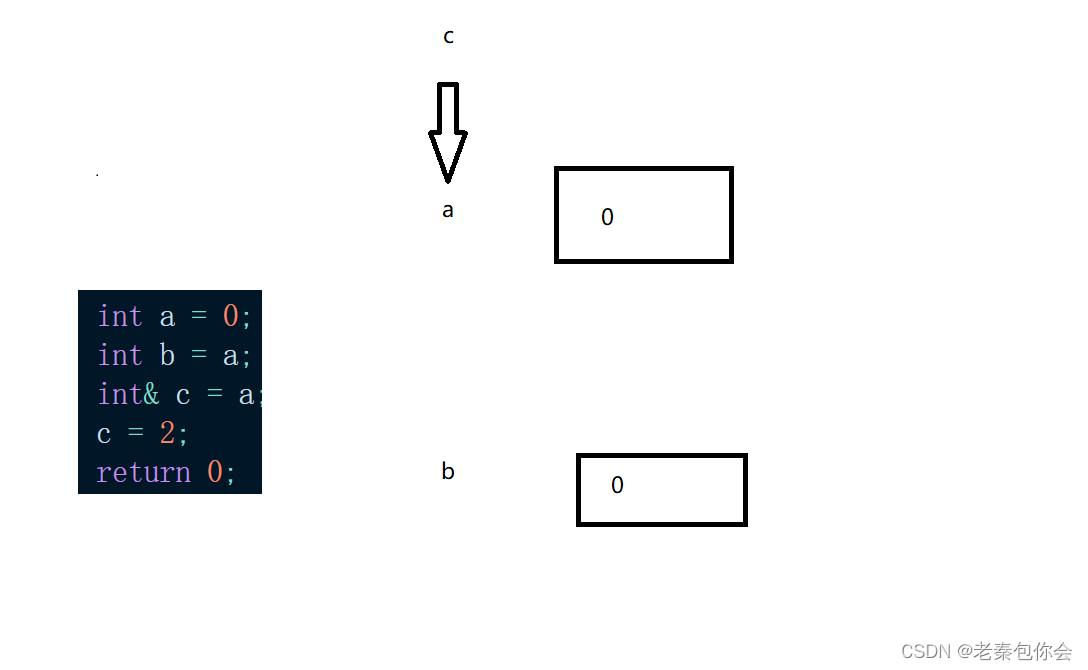

引用的好处
传参
前面我们学习过C语言如果要改变变量的值,要传地址
C语言版:
int exchang(int* a, int* b)
{
int temp = *a;
*a = *b;
*b = temp;
}
c++版:
int exchang(int& left, int& right)
{
int temp = left;
left = right;
right = temp;
return left;
}
引用的注意:
- 引用的时候必须初始化
- 引用的指向是唯一的,指定了就不能更改,所以说引用和指针是不能相互取代的
- 一个对象可以有多个引用,但是一个引用不能拥有多个对象
- 引用参数比直接传参的效率要高,引用参数和传地址参数的效率相似
以值作为参数或者返回值类型,在传参和返回期间,函数不会直接传递实参或者将变量本身直
接返回,而是传递实参或者返回变量的一份临时的拷贝,因此用值作为参数或者返回值类型,效
率是非常低下的,尤其是当参数或者返回值类型非常大时,效率就更低。
#include<iostream>
#include<time.h>
using std::cout;
using std::endl;
using std::cin;
void Fun1(int& a)
{
}
void Fun(int a)
{
}
int main()
{
int a = 12;
int b = a;
int i = 0;
int begin1 = clock();
for(i = 0; i < 1000000; i++)
Fun1(a);
int end1 = clock();
int begin2 = clock();
for (i = 0; i < 1000000; i++)
Fun(a);
int end2 = clock();
cout << end1 - begin1 << endl;
cout << end2 - begin2 << endl;
return 0;
}

返回值
在C语言中我们返回一个函数的值的时候,不是返回这个变量
int exchang(int a, int b)
{
int temp = a;
a = *b;
b = temp;
return a;
}
我们知道函数栈帧的创建和销毁,知道返回值是存在寄存器里面返回的
而在c++中
int& exchang(int left, int right)
{
int temp = left;
left = right;
right = temp;
return left;
}
返回的是left的引用,因为left在函数结束的时候就销毁了,所以返回的值是随机值,这样写是错误的写法,前面我们学习过递归的实现,空间是可以重复利用的,
#include<iostream>
#include<time.h>
using std::cout;
using std::endl;
using std::cin;
int& Fun(int a)
{
int c = a;
c++;
return c;
}
int main()
{
int& num1 = Fun(6);
cout << num1 << endl;
cout << num1 << endl;
Fun(1000);
cout << num1 << endl;
return 0;
}

这个代码可以看出来,num1引用的是c的原来的地址,函数结束,c销毁,但是那块内存还是存在,每次再调用,就会进行重复利用这块空间
正确的写法:
使用静态变量
前面我们知道如果使用静态变量的话,在静态区创建,而不是在栈区创建,这样就可以在函数销毁的时候静态变量不进行空间的释放
#include<iostream>
#include<time.h>
using std::cout;
using std::endl;
using std::cin;
int& Fun(int a)
{
static int c = a;
c++;
return c;
}
int main()
{
int& num1 = Fun(6);
cout << num1 << endl;
cout << num1 << endl;
Fun(1000);
cout << num1 << endl;
return 0;
}

静态变量只初始化一次
某些场景
#include<iostream>
#include<time.h>
#include<assert.h>
using std::cout;
using std::endl;
using std::cin;
typedef struct Seqlist
{
int a[100];
int size;
}SL;
void SLModify(SL *ps, int pos, int x)
{
assert(ps);
assert(ps->size > pos);
ps->a[pos] = x;
}
int& SLModify(SL* ps, int pos)
{
assert(ps);
assert(ps->size > pos);
return ps->a[pos];
}
int main()
{
SL lis = { {0},100 };
int i = 0;
for (i = 0; i < lis.size; i++)
{
SLModify(&lis, i)++;
}
return 0;
}
这里创建一个顺序表,如果要进行顺序表的每个元素进行加1,有两种方法,要么传地址,要么引用出来
常引用
这里介绍一下
const int a = 10;
这个 在c++中是常量,在C语言中是常变量
#include<iostream>
#include<time.h>
#include<assert.h>
using std::cout;
using std::endl;
using std::cin;
int main()
{
//引用权限不能放大
const int a = 10;
//int& b = a;错误的
const int& b = a;
//权限可以缩小
int c = 20;
const int& d = c;
const int& f = 10;
return 0;
}
在常数中,如果对常数进行引用,就不会随便的放大权限,常数不能更改,所以对应引用也不能更改,
常性
当我们如果使用使用不同的引用类型去引用一些不同类型的变量
如
int i = 10;
double j = i;
const double& rj = i;
如果是使用 double&就会报错,为啥? 因为我们在使用不同类型进行接收的时候,i会产生一个临时变量,(类型转变才会产生临时变量)并且这个临时变量具有常性,需要用const的变量进行接收。
指针和引用的区别
引用:
- 语法上,没有开辟空间,在底层实现上实际是有空间的,因为引用是按照指针方式来实现的。
- 引用比指针使用起来相对更安全
- 没有NULL引用,但有NULL指针
- 有多级指针,但是没有多级引用
- . 在sizeof中含义不同:引用结果为引用类型的大小,但指针始终是地址空间所占字节个数(32
位平台下占4个字节)
#include<iostream>
#include<time.h>
#include<assert.h>
using std::cout;
using std::endl;
using std::cin;
int main()
{
int c = 20;
const int& d = c;
cout << sizeof(d);
return 0;
}

6. 指针语法上,开辟了空间,在底层实现上实际也是有空间的
7. 引用自加即引用的实体增加1,指针自加即指针向后偏移一个类型的大小
两者共同点:
1.引用的底层是汇编实现的
引用表面好像是传值,其本质也是传地址,只是这个工作有编
译器来做
内联函数
以inline修饰的函数叫做内联函数,编译时C++编译器会在调用内联函数的地方展开,没有函数调
用建立栈帧的开销,内联函数提升程序运行的效率。
#include<iostream>
using std::cout;
using std::endl;
using std::cin;
int Add(int a, int b)
{
return a + b;
}
int main()
{
Add(1, 2);
return 0;
}
这里是没有inline修饰,需要创建函数栈帧

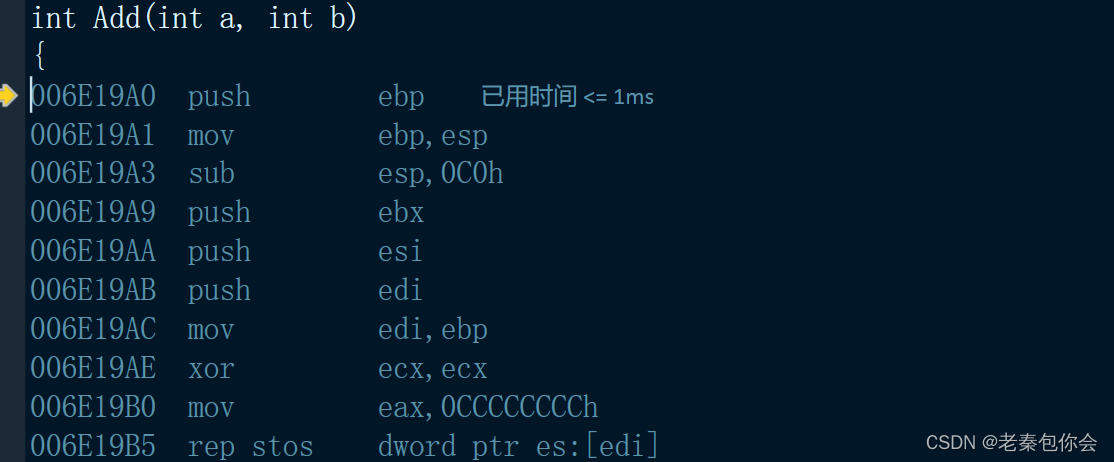
使用inline修饰
#include<iostream>
using std::cout;
using std::endl;
using std::cin;
inline int Add(int a, int b)
{
int c = a + b;
return c;
}
int main()
{
Add(1, 2);
return 0;
}
未显示展开

要想看到展开我们需要以下操作
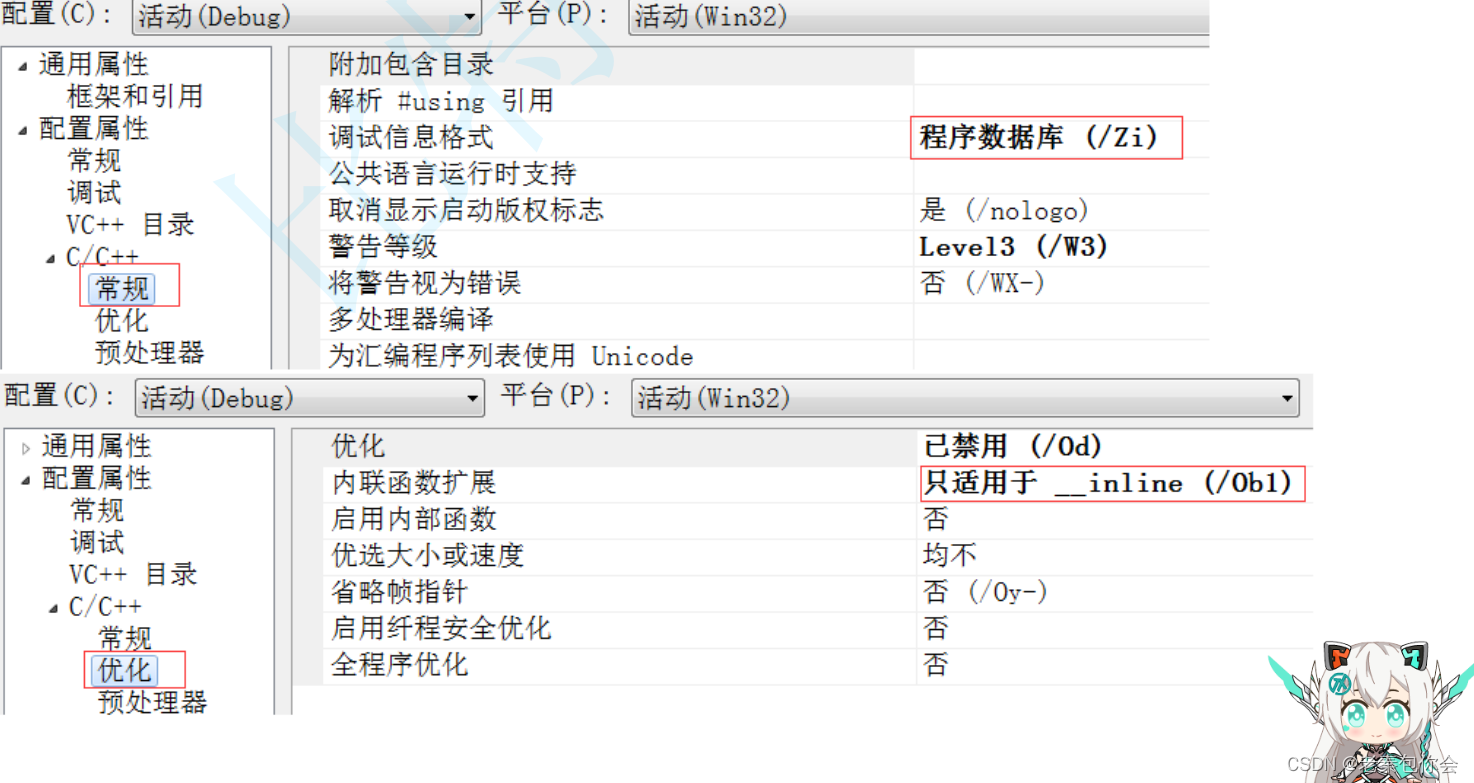

内联函数 优点:
- 可以调试
- 效率高,会展开
- 不用创建栈帧,提高效率
缺点:
不适合于大型的函数,每次调用inline修饰过的函数,就会展开一次,如果函数有100行,调用10000次,合计就要运行100 * 10000行,没有inline修饰的函数,每调用一次,就会找到相同的函数栈帧进行调用,总次数就是 100(函数的行数) + 10000(反汇编的call),所以inline修饰大型函数就会影响可执行程序的大小
inline对于编译器而言只是一个建议,不同编译器关于inline实现机制可能不同,一般建
议:将函数规模较小(即函数不是很长,具体没有准确的说法,取决于编译器内部实现)、不
是递归、且频繁调用的函数采用inline修饰,否则编译器会忽略inline特性。(简单的理解,看编译器的心情来决定展不展开)
需要注意的是,如果在其他cpp文件使用inline修饰函数,再到头文件声明,在其他cpp文件使用这个函数就会报错,因为使用inline修饰的函数在链接时不会生成符号表。这是因为inline函数在编译时会被直接插入到调用它的地方,而不会产生独立的函数代码。
day1_1.cpp
#include"day1_1.h"
int main()
{
fun(10);
return 0;
}
day1_2.cpp
#include<iostream>
using std::cout;
using std::endl;
using std::cin;
inline void fun(int a)
{
cout << a << endl;
}
day_1.h
#include<iostream>
using std::cout;
using std::endl;
using std::cin;
inline void fun(int a);

所以我们使用inline修饰函数,在对当前cpp文件或者在头文件定义和声明就行了
auto
auto关键字可以用于自动推导变量的类型,让编译器根据变量的初始化表达式推导出其类型,从而简化代码书写
#include<iostream>
using std::cout;
using std::endl;
using std::cin;
int main()
{
int a = 10;
int* b = NULL;
auto c = a;
auto& d = a;
cout << typeid(a).name() << endl;
cout << typeid(b).name() << endl;
cout << typeid(c).name() << endl;
cout << typeid(d).name() << endl;
return 0;
}

这里typeid(a).name()是返回a的类型
我们可以得出结论
- auto 必须初始化
- auto 不能当函数参数,返回值也不行
- auto不能声明数组
范围的for循环
与普通循环类似,可以用continue来结束本次循环,也可以用break来跳出整个循环。
前面我们学习过C语言的for循环语句,
int i = 0;
for (i = 0; i < 100; i++)
{
printf("%d ", i);
}
但是在c++中的for语句有点差别
#include<iostream>
using std::cout;
using std::endl;
using std::cin;
int main()
{
int a[] = { 1,2,3,4,5,6,7,8,9 };
for (auto e : a)
{
cout << e << " ";
}
return 0;
}
意思就是遍历一遍a数组,每个元素都依次赋值给e,自动判断结束, 修改e不会修改里面的元素
如果我们要修改元素的值
#include<iostream>
using std::cout;
using std::endl;
using std::cin;
int main()
{
int a[] = { 1,2,3,4,5,6,7,8,9 };
for (auto& e : a)
{
e++;
cout << e << " ";
}
return 0;
}
我们可以使用引用来进行修改
指针空值nullptr
#include<iostream>
using std::cout;
using std::endl;
using std::cin;
void func(int)
{
cout << "f(int)" << endl;
}
void func(int*)
{
cout << "f(int*)" << endl;
}
int main()
{
func(0);
func(NULL);
return 0;
}

这里的函数只写了类型,没有写变量,这个在c++是可以的,
看到结果的人可能会发现,为啥都打印了f(int),NULL不是指针类型吗,
其实不是,在c++
NULL实际是一个宏,在传统的C头文件(stddef.h)中,可以看到如下代码:
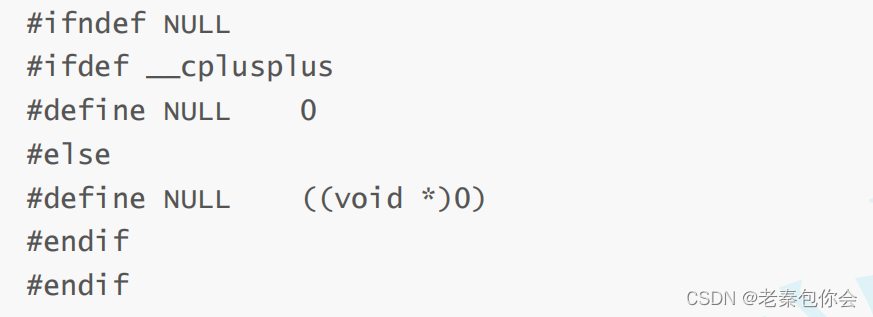
如果是c++就是把NULL定义成了一个宏,C语言就是一个指针类型
所以c++就为了弥补这个错误,就写出了一个nullptr来代表NULL空指针
注意:
- 在使用nullptr表示指针空值时,不需要包含头文件,因为nullptr是C++11作为新关键字引入
的。 - 在C++11中,sizeof(nullptr) 与 sizeof((void*)0)所占的字节数相同。
- 为了提高代码的健壮性,在后续表示指针空值时建议最好使用nullptr。
本文来自互联网用户投稿,该文观点仅代表作者本人,不代表本站立场。本站仅提供信息存储空间服务,不拥有所有权,不承担相关法律责任。 如若内容造成侵权/违法违规/事实不符,请联系我的编程经验分享网邮箱:veading@qq.com进行投诉反馈,一经查实,立即删除!